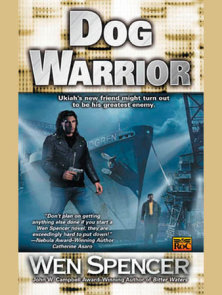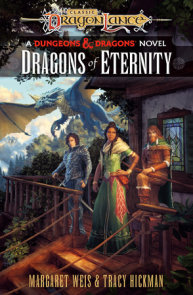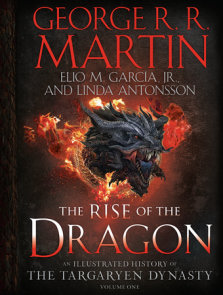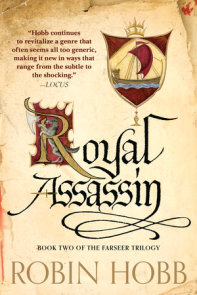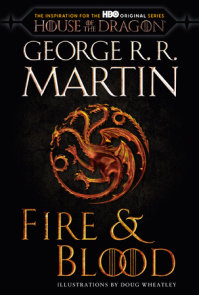TEACHING GUIDE
NOTE TO TEACHERS
The Shannara Trilogy
Teachers: If you’d like a printable version of this guide, click on the PDF link at the bottom of this page.
ABOUT THIS BOOK
Introduction/Plot Summary
Terry Brooks’ fantasy trilogy–The Sword of Shannara, The Elfstones of Shannara, and The Wishsong of Shannara–has enjoyed phenomenal popularity among readers of all ages since the first volume appeared in 1977. These stirring adventures, in which the forces of good struggle against an ancient, supernatural evil, are fast-paced, imaginative, and fun. The writing is simple and direct. The characters come to life quickly and believably in a setting that mingles the fantastic and the familiar. While the three books constitute a single work thematically, they can also be enjoyed and taught independently.
The Shannara Trilogy is a work of "high" or "heroic" fantasy, a genre indelibly associated with J.R.R. Tolkien’s masterpieces, The Hobbit and The Lord of the Rings, but whose roots lie in myth and fairy tale. Set in the timeless long-ago–"Once upon a time"–both transmit wisdom and experience by means of symbols and images that speak to us independently of logic or reason.
Myths address questions of worldly significance, often in elevated style. Fairy tales communicate more practical truths in a style of everyday discourse. Here the characters, whether tailor or princess, are emphatically human, with virtues and faults we recognize in ourselves. Even the giants, ogres and witches are drawn to human scale.
According to the mythologist Joseph Campbell, myths and fairy tales often share a three-part structure of separation, initiation, and return, which he termed the Monomyth. The hero receives a call to adventure–from an outside source or from within–that separates him or her from ordinary life. The ensuing quest leads the hero into a magical world where difficult, often painful or even tragic lessons must be learned. The completed initiation confers wisdom and power on the hero, who returns to the world transformed and, in turn, is able to transform the world.
Heroic fantasy is a hybrid of myth and fairy tale. It features ordinary characters and situations side by side with larger-than- life characters and situations. The writer of heroic fantasy attempts to enliven Campbell’s Monomyth with symbols that possess intense cultural vitality: elements drawn from Arthurian legend, Norse and Greek mythology. Those fantasies that successfully incorporate the wonder of these still–potent symbols can be extraordinarily powerful and satisfying.
Plot Summary–The Sword of Shannara
The Great Wars all but wiped humanity from the Earth. The few survivors fell so deeply into savagery that nearly a thousand years passed before a new civilization could be forged. But the world had been transformed. Strange new races had evolved–Dwarfs, Trolls, Gnomes, and Elves–adopting the names from old fictions. All would have been destroyed if not for the Druids–men of all races who banded together to preserve the scientific knowledge of the old world and foster peace in the new. In a bid for power, a Druid sorcerer named Brona gathered an army of men and waged the First War of the Races. Brona was defeated, but only to reappear five hundred years later as the Warlock Lord, kept alive by evil magic. Leading the Trolls and Gnomes against the Elves and Dwarfs, Brona launched the Second War of the Races.
Thinking Brona dead, the Druids had forbidden the study of sorcery, and were left helpless when Brona attacked. The Druid fortress of Paranor fell, but the Druid Bremen escaped. Skilled in the mystic arts, he forged a magic sword to use against the Warlock Lord, entrusting the blade to the Elven King, Jerle Shannara. In a final battle, Brona’s armies were beaten and Brona himself– along with Bremen–seemingly destroyed. The magic sword was sheathed in a block of stone at Paranor in case its magic was needed again.
This is a story the mysterious wanderer Allanon tells to Shea Ohmsford in The Sword of Shannara. The last of the Druids, Allanon reveals that the Warlock Lord has returned. Only a son of the House of Shannara can wield the Sword, and half-Elven Shea„adopted by the Ohmsfords after the death of his parents–is the sole descendant of Jerle Shannara.
Shea’s disbelief vanishes when a monstrous Skull Bearer appears in Shady Vale, dispatched by the Warlock Lord to kill him. Shea flees, carrying three Elfstones given him by Allanon–magical blue gems that will protect him in his quest for the sword. His adoptive brother, Flick, accompanies him; and soon the brothers are joined by Shea’s friend Menion, Prince of Leah. As the quest unfolds, and the three friends become separated, they will learn much about the "responsibilities of manhood", as each in his turn, is tested.
For Flick, the crisis comes when Allanon sends him to spy on Brona’s army. Despite the danger, Flick willingly infiltrates the enemy camp, not only out of love for Shea, who may be imprisoned there, but because he has finally learned to trust Allanon. When he finds that the prisoner is not Shea but Eventine, the Elven King, Flick acts in a manner he once would have considered foolhardy. Flick’s understanding of kinship has broadened to include men of other races.
Menion learns to temper his enthusiasm with caution as his romantic view of war wanes in the face of grim reality. His most significant lesson comes from the Dwarf warrior, Hendel, who places the quest above the pursuit of personal glory. Hendel’s tragic death in the cellars of Tyrsis is one of meaningful sacrifice. No longer the brash youth who embarked lightheartedly on an adventure, Menion is able to win the respect of seasoned warriors, as well as the love of Shirl Ravenlock.
Shea is tested more severely than his companions. When an earthquake strips him of everyone and everything he has relied on, Shea is suddenly left to his own devices. He reacts bravely when captured by Gnomes but cannot escape unaided, and his rescue only serves to resurrect the doubts he harbors about himself and the quest. He fails to recognize the Sword of Shannara when it is in his grasp, because he has failed to know himself. Only after a Gnome absconds with the Sword does Shea accept the responsibility thrust on him by fate. When at last he enters Brona’s dark domain, he is ready to draw the Sword and face the Warlock Lord.
However, the nature of the Sword’s vaunted magic proves to be unexpected. While the Sword of Shannara possesses the power to reveal Truth, Shea wonders how truth alone can defeat the Warlock Lord. The answer lies in the nature of magic, which Allanon explains is illusion given substance by belief. This insight would be useless to Shea had he not already learned to trust himself. Where he is able to look into himself and accept what he finds there, the Warlock Lord cannot. Brona’s very existence is illusory. When Shea strikes with the Sword, the Warlock Lord is effectively destroyed by his own nonexistence.
Allanon remains an aloof figure, though it is evident that the Druid carries a heavy burden. We learn that Allanon is the son of Bremen, whose "shade" has survived in a kind of limbo. We learn, too, that Allanon’s use of magic has depleted him. "I have a debt that must be paid," he tells an uncomprehending Shea. We will learn more of this debt–and the terms of its payment–in succeeding volumes.
Plot Summary–The Elfstones of Shannara
Fifty years after the defeat of the Warlock Lord, a more terrible evil stalks the land. Long before the Great Wars, magical creatures dominated the Earth. Some revered life; others sought to destroy it. In a war fought between these creatures, a spell of forbidding banished the evil forces to a limbo-like dimension. The spell originated with the Ellcrys, a sentient tree born from the Earth’s mystic life source, the Bloodfire. As long as the Ellcrys lived, tended by the Elves, the demons would remain banished.
Now, after countless millennia, the Ellcrys is dying. The most powerful and evil demon, the Dagda Mor, has escaped, and soon all the demons will be free–unless a seed from the Ellcrys is bathed in the energies of the Bloodfire, permitting a new tree to grow. The Elves, however, have lost the magic they once possessed. They know of no way to protect the seed or the seed-bearer-the Elven-girl Amberle-from the Dagda Mor. Worse, the whereabouts of the Bloodfire was lost in the Great Wars. Not even the Ellcrys can point the way. Allanon appears at this moment of crisis, unchanged despite the passage of time. Again he turns to a descendent of Jerle Shannara: Shea Ohmsford’s young grandson, Wil, who is studying to be a healer. In possession of the Elfstones once carried by Shea, Wil must guide Amberle into the Wilderun, a haunted wilderness where the Bloodfire may be found. Like Sword, Elfstones is concerned with sacrifice and redemption. But the focus sharpens and darkens as we learn more about the double-edged nature of magic and the mysterious figure of Allanon.
Because Wil has less Elven blood than his grandfather, he cannot control the Elfstones; his human side blocks his access to the magic–or so he believes. Each time he makes use of the Stones, the magic changes him, and not always for the better, he feels. Wil’s resistance to change thwarts him. Only when forced to protect Amberle and the Rover Eretria from the Reaper does Wil learn to believe in himself. Putting aside his selfish fears, he accepts the toll the Elfstones exact from him, and only then does he becomes a healer in the deepest sense of the word. This change is reflected in his ability to mourn Amberle’s loss without bitterness, and to accept the love of Eretria and acknowledge his love for her.
In many ways Amberle resembles Shea. She is reluctant to accept a responsibility she has not freely chosen, and she rejects her position as one of the Chosen, preferring to teach children "to love and respect the world." But she cannot save the world by withdrawing from it. As Allanon tells her: "[R]esponsibilities are sometimes given you without choice, without consent." Amberle fears the Ellcrys. The intimacy of their wordless union threatens her individuality. She recoils from the invasive touch of its branches, its mind. What Amberle truly fears, however, is the fearsome sacrifice required of her. Amberle gradually comes to understand that only by embracing that sacrifice can she be true to herself. When, within the Bloodfire, she renounces her Elven life to become the next Ellcrys, she is following the very principle she sought to impress upon her students: "I teach them to give life back in exchange for the life they were given . . ." Her metamorphosis is the expression of her highest ideals, and, by incorporating redemption, transcends the tragic.
By withholding information about the risks involved, Allanon demands more of Wil and Amberle than they know. Yet the Druid demands as much of himself. Steeped in the mystic arts, Allanon pays the heaviest price of all. Just as the Druid Brona was seduced by sorcery into becoming the Warlock Lord, Allanon’s struggle against the dark temptations of magic has marked him physically and spiritually. As he tells the Elven prince Ander Elessedil: "[M]agic takes life from the user–it drains strength and being. Something of what is lost can be recovered, but recovery is slow. And there is pain . . ."
Confrontation with The Dagda Mor leaves Allanon shockingly aged and weakened. Still, the Druid does not hold back or complain. Cut off from others by his power and knowledge, he acts selflessly nevertheless. Allanon’s suffering and stoic endurance adds a tragic dimension to his character–a dimension fully explored in the final volume.
Plot Summary–The Wishsong of Shannara
Twenty years after the defeat of the Dagda Mor, Allanon returns to seek the help of Brin Ohmsford, young daughter of Wil and Erietria. The changes wrought in Wil by the Elfstones have manifested themselves in Brin and her brother, Jair. The siblings possess a magical ability called the wishsong. For Jair, the wishsong only seems to cause things to change„his magic is illusion- but when Brin sings, she can join with any living thing.
Allanon tells Jair and Brin and their friend Rone Leah, great-grandson of Menion, about the Ildatch, a book of dark magic that corrupts whoever dares use it. It was the Ildatch that transformed Brona into the Warlock Lord. Some of the Warlock Lord’s followers hid the book in a valley called the Maelmord, where the Ildatch’s magic changed them to inhuman Mord Wraiths and turned the Maelmord into a forest of living evil too powerful for even Allanon to pierce. Only Brin can enter the Maelmord and destroy the Ildatch before its evil poisons the land forever.
Like her father and great-grandfather, Brin fears the power she wields and the price it may demand of her. But in the end she agrees to help Allanon, promising herself that she will never use the power of the wishsong to kill.
When Brin and Rone depart with Allanon for the Maelmord, the Mord Wraiths move quickly against Jair, who barely escapes with the Elfstones, only to be captured by Gnomes. An unusual friendship springs up between a Gnome tracker called Slanter and Jair, after he is rescued by the Weapons Master, Garet Jax. The three agree to go to Culhaven, where Jair expects to find Allanon and Brin. Along the way, however, the mysterious King of the Silver River informs Jair that Brin’s quest will fail without his help. He relieves Jair of the Elfstones, giving him, in exchange, a pouch of Silver Dust that will restore life to the Silver River–poisoned by the Ildatch„and a vision crystal that will show him the face of Brin wherever she may be. Before Jair and his companions leave for the Maelmord, Jair receives the power to make his wishsong’s illusions real„but only once.
Brin, Rone and Allanon arrive in the Valley of Shale, where the Druid has been summoned by his father’s shade. There, Bremen tells Allanon that, "The age ends. The circle is closed." Allanon places a measure of his own power into Rone’s sword so the young prince may better protect Brin. Then the Druid leads Brin and Rone to Paranor, which has been invaded by the Mord Wraiths. To safeguard the ancient knowledge, Allanon destroys the fortress and all within. Allanon tries to prepare his companions for the future by speaking of the past.
Knowing that Brona would return even after his defeat in the Second War of the Races, Bremen invested Allanon with the power to preserve his life through sorcerous sleep; then, through his son, Bremen bound his own spirit to the world. Since that time, Bremen has existed in a prison of his own making, from which he will be released only when the Ildatch is destroyed. With the passing of the age, Allanon, too, will die. His only concern is for the future care of the Races of Man in his absence.
Beside the waters of the Chard Rush, Allanon is attacked by a creature of insane and poisonous sorcery–the Jachyra. Although he kills the Jachyra, Allanon is mortally wounded. Before dying, he marks Brin’s forehead with his life’s blood, bequeathing the trust and obligation he inherited from Bremen.
Brin must now rely solely on the wishsong. She heals Rone with the magic. But an encounter with the ghastly Grimpond causes her to fear what she may become. Deciding that she must part company with Rone and her new friends–the old man Cogline, his granddaughter Kimber and the great cat Whisper–lest they come to harm because of her, Brin uses the wishsong to slip away. Underlying her apparent altruism, however, is selfishness and fear, carefully shaped by the Ildatch. Her noblest instincts have been turned against her. As she enters the Maelmord, instead of using the wishsong to destroy the dark magic animating the forest, Brin joins with it and is drawn to a tower at the center of the jungle, where the Ildatch awaits her.
Not even Allanon had suspected the truth: the book is alive–sentient. With subtle cunning, the Ildatch has used the Druid’s death to bring Brin a step closer to embracing the dark magic. "All that has brought you to this place and time has been because of me," the book whispers in her mind. Everything that has gone before–Shea’s quest, Wil’s adventures, Allanon’s death–has been the work of the Ildatch–or so it claims. Mixing truth and falsehood, the Ildatch assures Brin that it is not evil in itself, but has only been put to evil use. Though a part of her understands the truth, Brin has already been subverted by the dark magic she came to destroy.
Just when all seems lost, Jair uses the power of the King of the Silver River to go to Brin. When she lashes out at him with the wishsong, Jair pits his illusions against her, trying in vain to break the hold of the Ildatch. Ultimately he realizes that he cannot hide behind illusion. Daring the dark magic, he embraces her, his touch awakening memories of who she is, his selfless love recalling her to herself. Strong enough now to resist the Ildatch, she destroys it.
Beside the waters of the Chard Rush, the shade of Allanon appears to Brin. The wheel of time had come round, and the age has ended. "No Druids shall come after me," he tells her, "but the trust that was theirs resides now with you." Though the age of magic is over, Allanon foretells a distant future when Brin’s descendants, the children of the House of Shannara, will be called upon once more to wield the Elven magic in defense of all that lives.
DISCUSSION AND WRITING
Questions The Sword of Shannara
1. Why does Shea resist what Allanon reveals about the role of humanity in and after the First War of the Races? How does the Druid’s version of history differ from Shea’s? Is one version true and the other false? Is there an objective way to determine historical truth?
2. Shea tells Allanon: "Central governments have always been the greatest danger to mankind. Now there are none–small communities are the new rule of life. Some things are better left alone by everyone." Does Sheas opinion change by the end of the book? Why or why not? Do you agree or disagree with Shea? Does his statement express a common point of view in the United States today? Provide examples.
3. According to Allanon, men today have forgotten the past; they know little of the present and less of the future. Based on this view, is Allanon optimistic or pessimistic about the prospects of the races of man? Do his actions accord with his statements?
4. Briefly relate the history of Brona and the Skull Bearers. Include the origin of the name "Brona."
5. On the banks of the Silver River, Shea and Flick are saved from a Skull Bearer by a mysterious old man. What is the object the old man uses? What word does he use to refer to it . . . and why?
6. Why does Allanon warn Shea to use the Elfstones only as a last resort?
7. Why is it that Shea alone can wield the Sword of Shannara? Why does Allanon call this "the greatest irony of all"?
8. Why doesn’t Shea recognize the Sword the first time he sees it? What does this tell us about the nature of the Sword . . . and about Shea?
9. What is the disagreement between Balinor and his brother, Palance? When Balinor returns to Tyrsis, he goes to the palace despite being warned to stay away. Do you think Balinor is being foolish or brave? Is his love for Palance a weakness or a virtue? Does Balinor place the welfare of his kingdom above that of his brother and father? Why or why not?
10. Why does Stenmin attempt to murder Menion Leah?
11. Compare and contrast the relationship of Allanon and Shea with that of Stenmin and Palance.
12. Do you think Menion is justified in killing Stenmin even though the mystic is unarmed? Describe another moment when Menion is faced with the choice of killing an unarmed man. Are the two occasions different — or is it Menion who has changed?
13. What is the power of the Sword of Shannara? What does it do to Shea? To Orl Fane? To the Warlock Lord? Why does the Sword have a different effect on each of them?
14. How is Shea changed by the Sword? What other things have changed him in the course of his adventures? Does Allanons opinion of Shea reflect these changes?
15. In the literary technique of "doubling," the author splits off aspects of one character into a second character, so that the second character becomes a mirror image of the first. Keeping in mind that images in a mirror are reversed, discuss with respect to the characters of Shea and Orl Fane. What other examples of doubling can you find in The Sword of Shannara?
16. What price must Allanon pay for his longevity?
17. What is Allanons relationship to Bremen?
18. Who unexpectedly appears at the Ohmsford’s inn at the end of the book? What has he brought with him . . . and does he tell Shea’s father the truth about how he got it? Does this ending change your understanding of Shea’s escape and the sacrifices that made it possible?
Questions The Elfstones of Shannara
1. Briefly relate the history of the Elves. How are they different from the other Races of Man? Describe the significance of the Ellcrys.
2. What three things make Amberle different from her fellow Chosen?
How can the Forbidding be renewed?
3. Compare and contrast Ander Elessedil and his brother, Arion. Which of them do you think would make a better king? Why?
4. Why does Allanon’s appearance shock Eventine?
5. What has Amberle done to earn Eventine’s displeasure? Does she believe she deserves it?
6. Why does Allanon need Wil?
7. Both Elves, in the past, and humans, in the present, embrace isolationist policies as a protective strategy. Is it an effective strategy? Why or why not?
8. Why are there three Elfstones?
9. Amberle tells Wil, "We first need to understand who we were before we can understand who we are." What does she mean? Trace this theme through the book.
10. Describe the Elven attitude towards the Earth.
11. Wil calls himself a healer, yet in protecting Amberle he must use the Elfstones to hurt or even kill. Is this a betrayal of his principles? Why or why not?
12. Is Eritrea a typical Rover woman? Why or why not?
13. Compare and contrast Wil’s feelings for Amberle and Eritrea. How do they change over the course of the book?
14. Why does Wil have difficulty using the Elfstones?
15. How does the Dagda Mor know Allanon’s plans?
16. What is the nickname of Stee Jans, Commander of the Free Corps? How did he come by it?
17. Who are the Witch Sisters?
18. Compare Wil’s fear of the Elfstones with Amberle’s fear of the Ellcrys. How do they face and overcome this fear?
19. Describe Amberles sacrifice and relate it to the Elven way of life.
20. What price does Allanon pay for using his magic? Is Allanon’s sacrifice comparable to those of Amberle and Wil. Why or why not?
Questions The Wishsong of Shannara
1. Describe the magic of the Wishsong in Jair and Brin. How did they acquire the magic?
2. What is the history of the Ildatch?
3. What are the Mord Wraiths?
4. What is the Maelmord? Why can’t Allanon pass through it?
5. Brin thinks there is "something strangely sad" about Allanon. What is this sadness?
6. What does Allanon teach Brin about the Wishsong?
7. What makes Slanter different from other Gnomes? Is Slanter comfortable with being different?
8. Why does Slanter feel friendship for Jair?
9. Who is Garet Jax? Why does he agree to accompany Jair?
10. Why does the shade of Bremen call Brin "both savior and destroyer"?
11. What does Allanon do to make Rone Brin’s protector? How does this change Rone?
12. What does the King of the Silver River give to Jair? What does he take in return? Why doesn’t the King of the Silver River go the Maelmord himself?
13. Do you believe the King of the Silver River uses magic to manipulate Jair, Garet Jax and Slanter — or are their decisions freely made? Compare with the manipulations of Allanon and the Ildatch.
14. Why does Allanon destroy Paranor? Does his action have a larger meaning, and if so, what?
15. What are the Mwellrets? What powers set them apart from the other Races?
16. What is the guilt of the Druids for which Bremen must atone? Why does Allanon accept the burden of this guilt?
17. What is a Jachyra, and why is it so dangerous?
18. Why does Allanon mark Brin’s forehead with his blood?
19. Describe Whisper.
20. Who are Cogline and Kimber Boh?
21. What is the nature of Cogline’s magic? How does it differ from Allanon’s?
22. Compare the Grimpond and the shade of Bremen.
23. Why does the Grimpond call Brin "dark child"?
24. Kimber tells Brin, "One feels friendship and becomes bound by it." Does Brin accept this definition of friendship? Does Jair?
25. Why does Brin leave Rone, Kimber, Cogline and Whisper?
26. What are Procks?
27. How does Brin use the Wishsong to enter the Maelmord?
28. What is the secret of the Ildatch?
29. Compare and contrast the magic of the Wishsong and that of the Ildatch.
30. How does the Ildatch seduce Brin? Why cant she resist?
31. Slanter tells Jair, "These choices been made long before this about living and dying, boy! You can’t change that. You don’t have the right!" Why doesn’t he have the right? Does Brin believe she has the right?
32. Jair’s Wishsong has the power to create illusions, while Brin’s can alter reality. Does one of the two prove stronger . . . or are they both needed to defeat the Ildatch? Why?
33. Is the power of love opposed to that of magic? Explain why or why not using examples from the book.
34. What parallels exist between the fate of the Maelmord and that of Paranor?
35. What does Allanon prophesy for the future now that the Age of Magic has passed? Is the Druids view of history like an arrow pointing forever forward or a circle turning back upon itself? Do you agree or disagree with this view?
Questions About The Trilogy
1. It is characteristic of heroic fantasy that fairy tale be revealed as fact and myth as history. Terry Brooks gives the theme an original twist by setting his fantasy in the far future instead of the forgotten past. The Great Wars are holocausts of nuclear and biological weaponry, the new Races of Man (with the exception of the Elves) mutated survivors. Does this mean The Shannara Trilogy is science fiction? Why or why not? Do you believe something like the Great Wars could happen in our future?
2. How does the implicit link to present day reality (i.e., the suggestion that the world of Shannara will develop from our world) affect your reading of the fantasy? Discuss with regard to technology and the environment, racial prejudice, historical memory, and the nature of power.
3. In what ways do the adventures of Shea, Wil, Amberle, Brin, Jair and Allanon follow or depart from the three-part structure of the monomyth?
4. Do you believe Allanon is a tragic figure? Discuss with reference to the themes of guilt, sacrifice and redemption, using characters from each book.
5. Allanon withholds important information from Shea, Wil, and Brin. What are his reasons? Do you believe he is right or wrong? Why?
6. The Sword of Shannara resembles Excalibur, King Arthurs sword. Amberle’s fate suggests the myth of Apollo and Daphne. Brins journey into the Maelmord evokes the fairy tale of Sleeping Beauty. What other myths and fairy tales can you find in the Shannara trilogy? How are they altered, and why?
7. Discuss the nature of magic with special attention to the Sword, the Elfstones, Druid magic, the Wishsong and the Ildatch. Compare and contrast with the uses and misuses of art, technology, and political power in our world.
8. The King of the Silver River appears in each book of the Trilogy. How does he help Shea, Wil and Jair . . . and why?
9. Can Allanon be seen as a Christ figure? What, if any, is the difference between the literary use of a religion such as Christianity, on the one hand, and myth and fairy tale, on the other?
10. The Shannara trilogy records the passing of the age of magic. What do you think will be the nature of the age that succeeds it? From your own experience and knowledge of history, identify some ages through which civilization has passed. What name would you give to the present age of mankind? Why?
ABOUT THIS GUIDE
This teachers guide was written by Paul Witcover. Paul witcoveris the author of Waking Beauty, a novel, and Zora Neale Hurston, a biography. He lives and writes in New York City.
×
Become a Member
Just for joining you’ll get personalized recommendations on your dashboard daily and features only for members.
Find Out More Join Now Sign In









